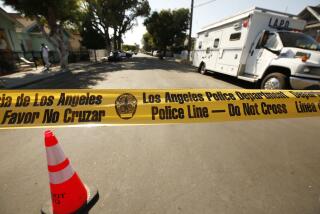Another Explosive Issue for the MTA
- Share via
Critics of the Los Angeles subway should get a bang out of this: The MTA plans to set off 125 tons of explosives under the Hollywood Hills--and on an active earthquake fault no less--as part of the Metro Rail construction project.
But don’t worry, transit officials say. You’ll hardly notice a thing.
Blasting will begin next summer and continue for a year--day and night during some periods--and take place 250 to 900 feet under Runyon Canyon Park, the former retreat of swashbuckling 1940s film star Errol Flynn.
Transit officials insist that the blasting will cause no damage to homes.
Residents are understandably wary. This is, after all, the same agency that has left in its path a giant sinkhole on Hollywood Boulevard, bitter feelings and hundreds of claims and lawsuits from property owners along the Downtown-to-San Fernando Valley route.
Plans call for using emulsion gel explosives up to eight times a day to remove hundreds of truckloads of rock over the course of a year.
While a boring machine is being used to dig a pair of tunnels from the Universal City side of the mountain, on the Hollywood side, explosives are needed to blow out a 600-foot-long section of the 2 1/2-mile-long tunnels.
The only thing that residents should feel is a very low vibration--”as if children were jumping on a bed,” said Jim Sowell, manager of environmental compliance for the Metropolitan Transportation Authority’s construction division.
“When my kid was a teen-ager, he would come down the stairs about four or five at a time. Bam, bam, bam! I’m sure we had some vibrations in our house that were exceeding what we’ll have here.”
Animals should not be disturbed by the explosions either, transit officials assure.
At most, you might feel a “flutter of your windows or a buzzing of the china sitting in your cabinets,” he said.
And you won’t hear anything either, Sowell said. The MTA has installed doors in the tunnels and 20-foot-high barriers around a ventilation shaft in the park.
The MTA has been trying since the beginning of the year to get subsurface easements from 94 mountain residents to tunnel 60 to 900 feet below their property. Only 20 have sold easements--for an average of $2,000 each. The transit agency is contemplating condemnation proceedings for the remainder.
To keep residents from attributing earthquake damage or other structural problems to the blasting, fire officials plan to install seismographs around the neighborhood.
What about blasting on an active fault?
“We have discussed this at great length with the Caltech people,” Sowell said. Scientists conducting earthquake research last year set off several thousand pounds of explosives on faults, he noted. The MTA plans to set off three to four hundred pounds of explosives in each shot.
“The explosives for the tunnels are only several hundred feet down. They’re nowhere near the source region for an earthquake,” said Kerry Sieh, a Caltech professor of geology, noting that temblors often originate several miles deep in the earth.
The explosives are needed to carve out a larger section of tunnel where the subway route crosses the Hollywood Fault. “If an earthquake should occur and shift the ground, “we won’t have to dig a new tunnel,” said Sowell. He added: “Tunnels are a very safe place to be in an earthquake. . . . We have motion detectors built into our train control systems, so if they detect an earthquake starting, they shut the train down.”
The explosives also will be used inside the mountain to provide room for trains to switch tracks, for equipment storage and for cross-passages between the tunnels every 750 feet, a total of 18.
Critics of the subway have already jumped on the “underground bombing campaign,” as state Sen. Tom Hayden (D-Santa Monica) has called it, to push for an end to the $5.8-billion project.
*
“If you look back at what they said about Hollywood Boulevard, I’m sure you will find they promised the property owners that there would only be a few vibrations,” Hayden said. “In fact, they put a lot of people out of business.” The MTA disputes that assertion, contending that all structural damage was caused by the January, 1994, earthquake.
Transit officials said explosives have been routinely used for home and road construction in the Santa Monica Mountains and for other big projects.
“Right Downtown, with Arco Towers, the whole sub-basement area was dug out by several hundred thousand pounds of explosives,” Sowell said.
The blasts will be monitored by inspectors from the Fire Department and Cal/OSHA, the state job safety agency.
Portland, Ore., has been using explosives for more than a year--at about the same depth planned by the MTA--to build a tunnel for its rail line.
“If you are able to provide the information in advance and offer some mitigation measures, they’re able to accept this inconvenience,” Jan Schaeffer, a spokeswoman for the Portland transit agency, said of community reaction.
She said that a number of residents 200 feet above the blasting complained that they were being awakened at night, so the city stopped blasting between midnight and 6 a.m.
But Portland’s experience cannot necessarily be applied to Los Angeles because geological conditions can vary greatly, Schaeffer said.
Los Angeles County Supervisor Zev Yaroslavsky, whose district includes the blast site, said he will review the MTA’s plans.
“If this thing is going to proceed, there needs to be the highest level of assurance that there will be no adverse impact,” said Yaroslavsky, who serves on the MTA board.
Train service between Hollywood and North Hollywood is scheduled to begin in 2001.
More to Read
Sign up for Essential California
The most important California stories and recommendations in your inbox every morning.
You may occasionally receive promotional content from the Los Angeles Times.











